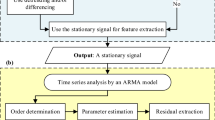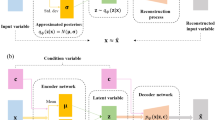Abstract
In this paper, the vibration-based image representation and data fusion demonstrates distinctive benefit in feature extraction, yielding superior performance for damage identification in railway engineering. Specifically, based on vehicle-track coupled dynamics, the rail vibration datasets under diverse fastener damage conditions are generated. By converting 1-D vibration signals into 2-D grayscale images with recurrence plots (RPs) and the aid of conditional variational autoencoder (CVAE), the acceleration RPs and displacement RPs are fused for enhancing feature extraction. It is demonstrated that detecting the variation in texture patterns and color distribution of the vibration-based images facilitates effective damage identification, mitigating the sensitivity of damage recognition to the deterioration of track irregularity. The results show that the displacement RPs characterised by quasi-static features are more suitable for fastener damage identification. Further, by employing the data fusion that combines both the random dynamic features of the acceleration RPs and quasi-static features of the displacement RPs, the tolerance of measurement range for accurate fastener damage identification can be extended. The robustness of the proposed method is validated after testing different sampling frequencies and additional noise.
















Similar content being viewed by others
Data Availability
Not applicable.
References
Wei, K., Wang, F., Wang, P., et al.: Effect of temperature-and frequency-dependent dynamic properties of rail pads on high-speed vehicle–track coupled vibrations. Veh. Syst. Dyn. 55(3), 351–370 (2017)
Jian, Y., Tang, L., Hu, G., et al.: Adaptive genetic algorithm enabled tailoring of piezoelectric metamaterials for optimal vibration attenuation. Smart Mater. Struct. 31(7), 075026 (2022)
Dou, Y., Wang, P., Ding, W., et al.: Effect of viscoelastic-plastic dynamic properties of rail pads on curved rail dynamic characteristics based on the modified SEM–SM hybrid method. Veh. Syst. Dyn. 61(1), 58–82 (2023)
Hussein, M.F., Renno, J.M., Muthalif, A.G.: Energy harvesting from railway slab-tracks with continuous slabs. J. Vib. Control 29(3–4), 882–901 (2023)
Jian, Y., Hu, G., Tang, L., et al.: Analytical and experimental study of a metamaterial beam with grading piezoelectric transducers for vibration attenuation band widening. Eng. Struct. 275, 115091 (2023)
Li, F., Wu, H., Liu, C., et al.: Vibration fatigue analysis of high-speed railway vehicle carbody under shaking condition. Veh. Syst. Dyn. 60(6), 1867–1887 (2022)
Kim, K., Choi, J., Chung, J., et al.: Structural displacement estimation through multi-rate fusion of accelerometer and RTK-GPS displacement and velocity measurements. Measurement 130, 223–235 (2018)
Xiu, C., Weng, Y., Shi, W.: Vision and vibration data fusion-based structural dynamic displacement measurement with test validation. Sensors. 23(9), 4547 (2023)
Lee, H., Lim, H., Skinner, T., et al.: Automated fatigue damage detection and classification technique for composite structures using Lamb waves and deep autoencoder. Mech. Syst. Signal Process. 163, 108148 (2022)
Wu, Y., Zhu, X.: Rail defect detection using ultrasonic A-scan data and deep Autoencoder. Transportation Research Record. 2023; 03611981221150923.
Hatami, N., Gavet, Y., Debayle, J.: Classification of time-series images using deep convolutional neural networks. Tenth international conference on machine vision (ICMV 2017); 2018: SPIE.
Eckmann, J.P., Kamphorst, S.O., Ruelle, D.: Recurrence plots of dynamical systems. World Sci. Ser. Nonlinear Sci. Ser. A 16, 441–446 (1995)
Marwan, N., Romano, M.C., Thiel, M., et al.: Recurrence plots for the analysis of complex systems. Phys. Rep. 438(5–6), 237–329 (2007)
Zhang, Y., Hou, Y., OuYang, K., et al.: Multi-scale signed recurrence plot based time series classification using inception architectural networks. Pattern Recogn. 123, 108385 (2022)
Liu, X., Xia, L., Shi, J., et al.: A fault diagnosis method of rolling bearing based on improved recurrence plot and convolutional neural network. IEEE Sens. J. (2023). https://doi.org/10.1109/JSEN.2023.3265409
Yang, D., Ren, W.X., Hu, Y.D., et al.: Selection of optimal threshold to construct recurrence plot for structural operational vibration measurements. J. Sound Vib. 349, 361–374 (2015)
Bai, R., Meng, Z., Xu, Q., et al.: Fractional Fourier and time domain recurrence plot fusion combining convolutional neural network for bearing fault diagnosis under variable working conditions. Reliab. Eng. Syst. Saf. 232, 109076 (2023)
Sajedi, S., Liang, X.: Deep generative Bayesian optimization for sensor placement in structural health monitoring. Computer-Aided Civil and Infrastructure Engineering. 37(9), 1109–1127 (2022)
Wei, Y., Wu, D., Terpenny, J.: Learning the health index of complex systems using dynamic conditional variational autoencoders. Reliab. Eng. Syst. Saf. 216, 108004 (2021)
Pesteie, M., Abolmaesumi, P., Rohling, R.N.: Adaptive augmentation of medical data using independently conditional variational auto-encoders. IEEE Trans. Med. Imaging 38(12), 2807–2820 (2019)
Torres, H.R., Morais, P., Oliveira, B., et al.: A review of image processing methods for fetal head and brain analysis in ultrasound images. Comput. Methods Programs Biomed. 215, 106629 (2022)
Wang, X., Wang, K., Lian, S.: A survey on face data augmentation for the training of deep neural networks. Neural Comput. Appl. 32(19), 15503–15531 (2020)
Yang, L., Song, Q., Wu, Y.: Attacks on state-of-the-art face recognition using attentional adversarial attack generative network. Multimedia Tools Appl. 80, 855–875 (2021)
Bai, Y., Yang, J., Wang, J., et al.: Image representation of vibration signals and its application in intelligent compound fault diagnosis in railway vehicle wheelset-axlebox assemblies. Mech. Syst. Signal Process. 152, 107421 (2021)
Yi, C., Li, Y., Huo, X., et al.: A promising new tool for fault diagnosis of railway wheelset bearings: SSO-based Kurtogram. ISA Trans. 128, 498–512 (2022)
Susladkar, O., Deshmukh, G., Nag, S., et al.: ClarifyNet: A high-pass and low-pass filtering based CNN for single image dehazing. J. Syst. Architect. 132, 102736 (2022)
Doersch, C.: Tutorial on variational autoencoders. arXiv preprint arXiv:160605908. 2016.
Kingma, D.P., Welling, M.: An introduction to variational autoencoders. Found. Trends Mach. Learn. 12(4), 307–392 (2019)
Sohn, K., Lee, H., Yan, X.: Learning structured output representation using deep conditional generative models. Adv. Neural Inform. Process. Syst. 015(28), 48 (2015)
Yang, Y., Zheng, K., Wu, C., et al.: Improving the classification effectiveness of intrusion detection by using improved conditional variational autoencoder and deep neural network. Sensors. 19(11), 2528 (2019)
Zhai, W.: Vehicle-Track Coupled Dynamics: Theory and Application. Springer, Singapore (2020)
Tong, F., Gao, L., Hou, B., et al.: Influence of differential deterioration of random track irregularity at different wavelengths on high-speed train safety. Int. J. Rail Transp. 4, 1–23 (2023)
Xu, J., Li, Z., Du, B. et al.: Reluplex made more practical: Leaky ReLU. In: 2020 IEEE Symposium on Computers and communications (ISCC), IEEE, pp 1–7 (2020)
Jiang, T., Cheng, J.: Target recognition based on CNN with LeakyReLU and PReLU activation functions. In: 2019 International Conference on Sensing, Diagnostics, Prognostics, and Control (SDPC), pp 718–722 (2019)
Zheng, W., Dan, D., Cheng, W., et al.: Real-time dynamic displacement monitoring with double integration of acceleration based on recursive least squares method. Measurement 141, 460–471 (2019)
Acknowledgements
The authors acknowledge continuous supports by the China Scholarship Council and the Royal Society of New Zealand.
Funding
This work was supported by the Ph.D. scholarship from the China Scholarship Council (Grant No. 202007000010), Catalyst Seeding General Grant administered by the Royal Society of New Zealand (Contract 20-UOA-035-CSG).
Author information
Authors and Affiliations
Contributions
Conceptualization, Methodology and Writing—original draft were performed by SW. Supervision, Writing—review & editing and Funding acquisition were performed by LT. Software and Investigation were performed by YD. Writing—review & editing was performed ZL. Supervision was performed by KCA.
Corresponding author
Ethics declarations
Competing interest
The authors have declared that no competing interests exist.
Consent for Publication
Published informed consent were obtained from all participants.
Ethical Approval
Not applicable.
Informed Consent
Not applicable.
Additional information
Publisher's Note
Springer Nature remains neutral with regard to jurisdictional claims in published maps and institutional affiliations.
Rights and permissions
Springer Nature or its licensor (e.g. a society or other partner) holds exclusive rights to this article under a publishing agreement with the author(s) or other rightsholder(s); author self-archiving of the accepted manuscript version of this article is solely governed by the terms of such publishing agreement and applicable law.
About this article
Cite this article
Wang, S., Tang, L., Dou, Y. et al. Enhancement of Track Damage Identification by Data Fusion of Vibration-Based Image Representation. J Nondestruct Eval 43, 15 (2024). https://doi.org/10.1007/s10921-023-01028-7
Received:
Accepted:
Published:
DOI: https://doi.org/10.1007/s10921-023-01028-7




